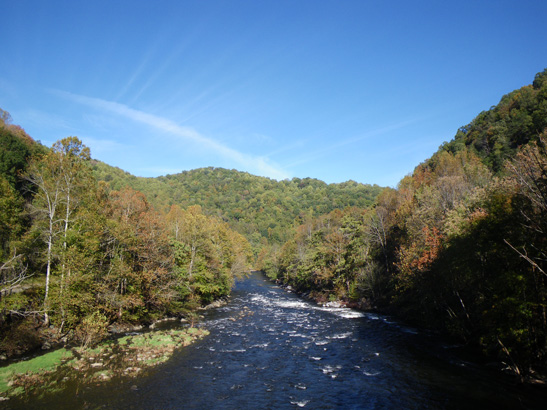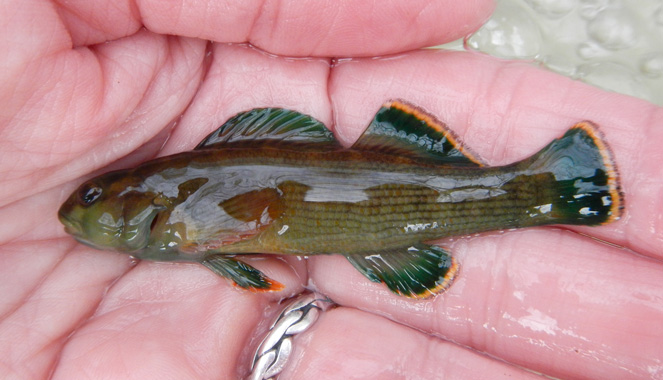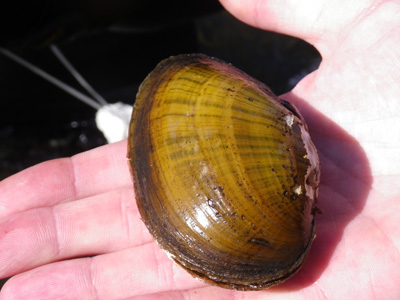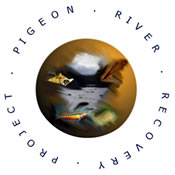Pigeon River Recovery Project History
Why it was implemented:
- Under TN Water Control Act, TN has right to unpolluted water
- TN must reclaim polluted waters
- TDEC initiated efforts restore the rivers ecosystem
- Paper mill began operations in 1908. Its toxic effluent extirpated all snails, mussels and most fish species
- Paper mill effluents included coffee colored tannins and lignins, toxics such as dioxin
- Modernization of mill processes drastically reduced waste effluent
- This led to a return of many fish species to the Pigeon; however, 24 non-game species were still missing
 Pigeon River from Brown's Bridge
Pigeon River from Brown's Bridge
Description of the best practice:
- In 1996, common river snails were re-introduced in the TN segment
- Their survival and re-colonization led to the creation of the PRRP
- PRRP goal is to help restore ecosystem health by increasing aquatic biodiversity through the establishment of viable, reproducing populations of native species
- Re-establishing native fish: Criteria for selecting candidate species to be relocated to the Pigeon River included historic range, available habitat, and source of fish within the watershed
- Collection by seining from streams within the watershed
- Tagging with various colors of Visible Implant Fluorescent Elastomer (VIE) to assess survival and reproduction
- Monitoring by snorkeling/seining surveys to locate tagged fish and their young
- Field tagging station: anesthetizing box, VIE (color represents season/year), measuring board, recovery tank, oxygen/temperature monitor, and oxygen aeration system
- Candidates for Re-introduction: gilt darter, bluebreast darter, blueside darter, stripetail darter, tangerine darter, stargazing minnow, blotched chub, mountain madtom, American brook lamprey, mountain brook lamprey, mirror shiner, saffron shiner, silver shiner, telescope shiner, Tennessee shiner and striped shiner
Survival, reproduction, and propagation:
- Survival of relocated fish and reproduction in TN led to expansion into NC
- Project made possible by support from UTK and funding from Blue Ridge Paper Products
- In 2004, CFI began propagation of the tangerine darter
Project milestones:
- Gilt darters, stripetail darter, silver shiners, telescope shiners and mountain brook lampreys are re-colonizing the Pigeon River
- Evidence of reproduction in three additional fish species
- Spring 2007, CFI/UT released the first propagated juvenile tangerine darters into the Pigeon River (a first!)
- Mussels re-introduced for the first time in NC reach below mill in 2011
- Mussels re-introduced at new site in 2011 in TN
How Best Practice was Developed:
- Conservation Fisheries, Inc. (CFI) began fish species re-introduction in 1986 and have continued their propagation and re-introduction efforts
- They conducted the 1st VIE tagging of darters
- PRRP based its methods and techniques on their successes
- Their background and experience in non-game re-introduction and propagation is unrivaled and their facility is one of a kind
Environmental Benefits:
- To date, the PRRP has re-introduced 20 species of fish, over 39,000 individuals into TN & NC segments of Pigeon River
- Evidence of reproduction in 9 species of fish
- Biodiversity has increased – 2 snails and 6 fish species are re-colonizing the river
Cost of Implementation – shared manpower, equipment, supplies and time
Return – priceless
Critical factor that led to success – teamwork
Lessons learned – characterize habitats and identify microhabitat parameters, where possible
Educational Outreach:
Kids in the Creek Program
Coal Creek Health Day
4-H
Tate's School of Discovery
Townsend TroutFest
Maggie Valley Trout Festival
TWISTER
Teacher's Forest Conservation Workshop
Casting for Recovery
LRWA Floatilla Event

Greenfin
For more detailed historical information follow this link:
Chronology of Important Fishery and Water Quality Events in the Pigeon River Watershed (pdf file) (primarily for Haywood County, NC)
 Coal Creek Health Day
Coal Creek Health Day

Lampsilis fasciola (mussel)
 Collecting Fish and Insects
Collecting Fish and Insects
 HWA Kids in the Creek Program
HWA Kids in the Creek Program


